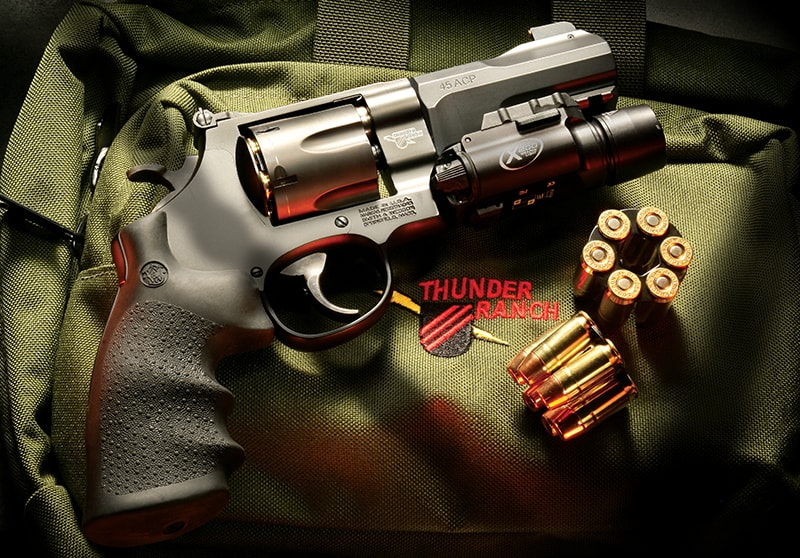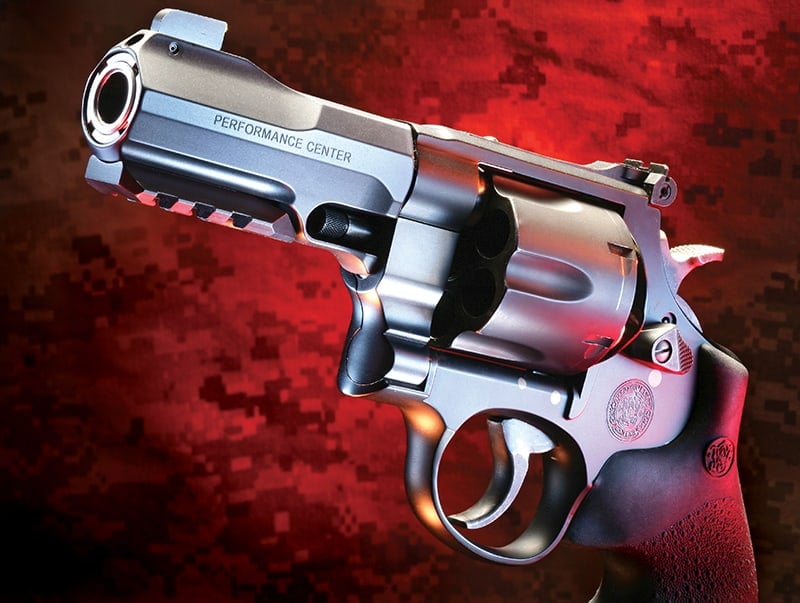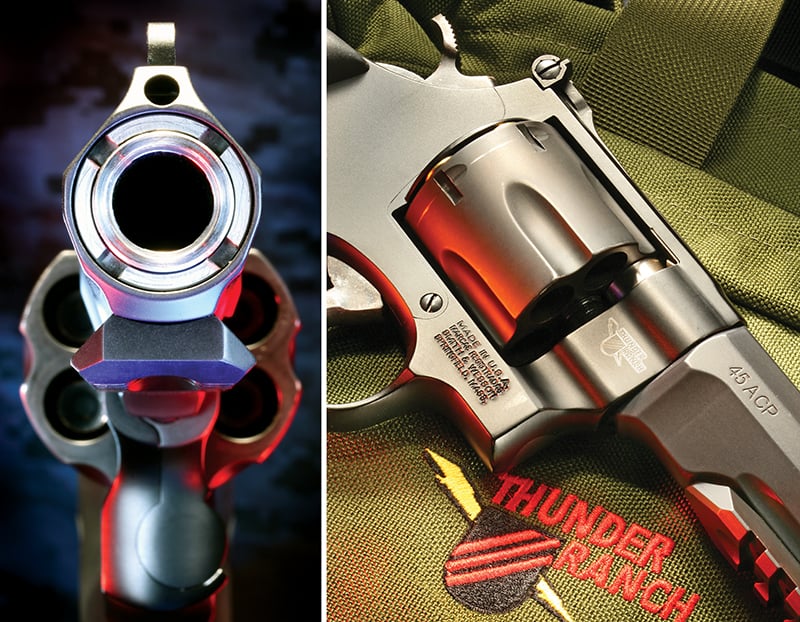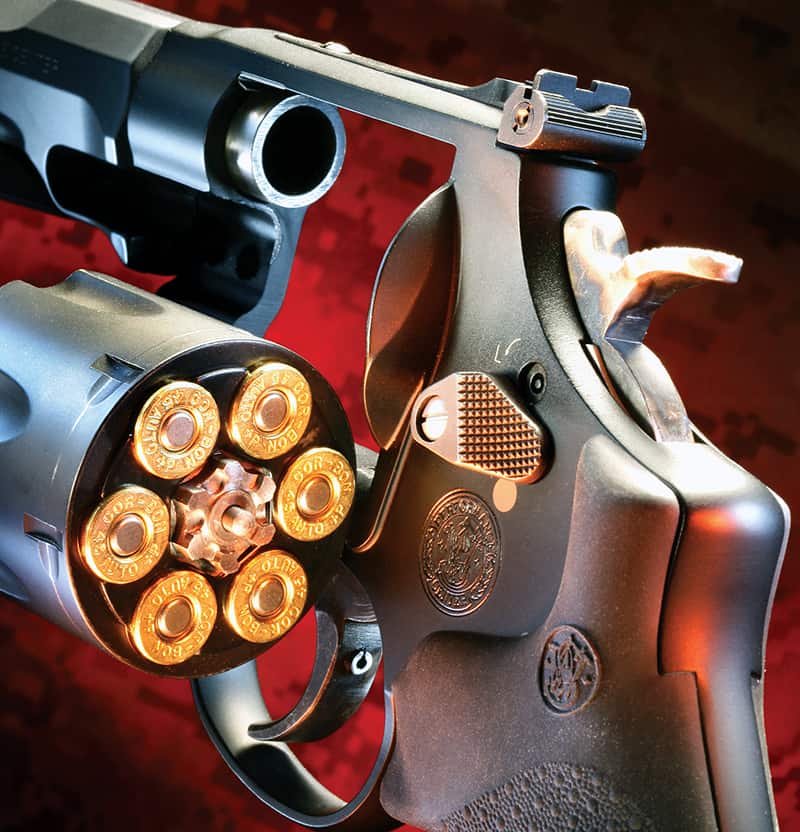Thunder Ranch Defensive Revolver
A "Modern Revolver"
They always say it can’t be done. I don’t know who they are but if you have the right idea and the people who are smart enough to listen, things can get done. If only Skeeter Skelton had known Tony Miele at S&W, he just may have seen his beloved .44 Special N-frames back in production before he passed away. I wish he would have, and confess I can’t look at one of S&W’s Classic series without thinking of Skeeter’s writing, and his laments S&W had quit making them. When I handled that first TR .44 Special (the first collaboration between Clint Smith and S&W) I kept thinking of how Skeeter would have smiled had he seen it.
After the success of that .44 Special (Model 21) and then the continued success of the Model 22 (.45 ACP) — also in collaboration with Clint and Thunder Ranch — S&W grew the “Classic” line to include the Models 40, 36, 1917 and the Model 29. It seems we baby-boomers dearly love our classic S&Ws, and aren’t hesitant to put our money down to prove it.
Yet, as is the case with many things, regardless of how good they may be, there are complainers. “This gun has a lock on it” or “The front sight’s not the same as the original” or “The grip’s not the same” or “I’m having a bad day and feel like whining, so I’ll whine about these guns.” This, from the same crowd who would be quick to castigate S&W for discontinuing the guns in the first place. So now these wonderful designs are back, at least in the spirit of the original in some cases, and they still complain. It sucks to be them, if you ask me. I, along with thousands of believers, will simply continue to enjoy this renaissance of revolvers from S&W, including these innovative models.
Notta 1911
So what only took two months? The new Thunder Ranch Defensive Revolver, .45 ACP, Model 325, that’s what. “What’s all this? Two months? That’s impossible!” say the nay-sayers. No it’s not, I saw it happen, and we not only have the t-shirt, but also the DVD to prove it.
“Clint,” said Tony Miele, “the Performance Center can do wonders with Scandium, light rails and more, so what about a new Thunder Ranch revolver from the Performance Center?” I was there during some of the exchanges and I heard it.
“Okay,” smiled Clint. “But it has to be a 4-something caliber, so we’re talking .44 or .45, as in .45 ACP.” Tony didn’t balk, “We’ll use the concept of the Model 327 .357 as a starting point, with a Scandium frame to keep it light, and a removable light rail, and we’ll make sure it can use full-moon clips.”
Clint smiled too, “And a gold bead front sight, and a forged hammer and trigger, and a stainless steel cylinder, barrel and shroud and a Performance Center action job?” I’ve never seen Tony hesitate with anything, but there might have been just a thousandth of a second hesitation. “Sure, no problem.”
“And — a 4″ barrel,” Clint looked at Tony over the top of his glasses. “But that means I’ll have to … ,” started Tony. “A 4″ barrel because the 5″ causes holster makers to have nightmares, a 3″ is too short and a 6″ is out of the question,” said Clint.
I pitched in with a, “Yup, he’s right, what he said, Tony. Clint’s right.” We were standing in the semi-secret engineering section of Tony’s domain, and Tony’s crack, ace-in-the-hole engineer (an actual gun-guy) nodded.
“Geez … I’d like to say ‘bite me’ but I hate to admit he’s right. Done.” And with that, the new Thunder Ranch Defensive Revolver was pretty much finalized. Clint and Tony had started prodding each other even earlier, but now the ball was officially set in motion and with more “Like this, not like that” calls and e-mails between the two of them, the final design was, well, finalized. Tony sent Clint the prototype (the gun in our pictures is the second prototype) and Clint proceeded to shoot a bit more than 5,000 rounds through it. Then he smiled again.
As a matter of fact, he sent the gun back to Tony who promptly called Clint and said, “What the hell did you do to this gun?” Clint simply said, “I shot it 5,000 times, isn’t that okay?”
“But it was just a prototype gun, a sample to test the basic concept, a oneoff, not a production gun. It was never made to stand-up to that kind of a test,” said Tony.
“But it did, didn’t it. Now, when can I get my gun back?”
That’s how it happened. Honest.
Real Guns
Clint is fond of saying “Wheelguns are Realguns” and I’ll bet many of you agree. Most gun-guys I know have at least a J-frame tucked away in a pocket, and more than likely cut their teeth shooting revolvers. If they are youngsters (less than, say, 40?) they may not have much experience, but probably can manage one well enough not to shoot themselves in their collective feet. Wheelguns are safe, reliable, carry enough rounds to solve most problems, and if it goes “click” and not “bang” you just pull the trigger again. No need to take your gun apart and put it back together to get back into the fight.
The .45 ACP was Clint’s choice for a couple of reasons. First off, it starts with a “4”, which is always a good thing in Clint’s book. And being .45 ACP, it would make a good companion piece for a die-hard 1911 shooter. The adjustable sights on the 325 would allow a shooter to regulate it to the same load he shoots in his auto. And in a pinch, you can load a revolver quite handily by simply snicking the rounds out of a 1911 magazine right into the chambers. There’s no moon-clip involved, but it does get you back into the grease if needed.
The light rail was a no-brainer. It also helps to manage Clint’s observations if you have one of something, you may have none of something if it fails. So, a weapon-mounted light to augment a hand-held light means, “One is none, and two is one.” Easy.
During the day, the lightweight 325 makes a comforting carry gun at a modest 31 ounces, especially in a Milt Sparks holster made just for it. At home at night, on goes the light, and you now have a reliable, full caliber home defense gun.
The Gun At-Hand
I had the joy of shooting the first prototype at Thunder Ranch while we were filming a DVD featuring Clint to include with the gun when they are shipped to buyers. My initial impression was a serious fighting revolver and my later tests proved it out.
The Performance Center at S&W can be compared to a formula one racing design and engineering shop. The best “mechanics” are assembled — in this the best gunsmiths — to push the envelope in design and production. And, like race cars, some of what you see in Performance Center guns may show itself in production guns.
Tony Miele put this expertise he has at hand to work on the 325 and the final package is all everyone hoped for. This lightweight, steel and Scandium .45 ACP, complete with light rail, adjustable sights, interchangeable gold bead front sight, smooth-faced trigger with stop, forged hammer and trigger and what appear to be rubber grips with finger grooves, is not only appealing to the eye, but feels like the serious tool it is in your hand.
The cylinder, shroud and barrel are all stainless, blackened with a proprietary process. The charge holes are chamfered to speed reloading (don’t forget the gun can use full-moon clips), but you can also use either loose ammo or half, or one-third moon clips if you need to. Other niceties include color case-hardened hammer and trigger, button rifled barrel, a ball detent lockup, an “old school” pinned double action sear and even a gun rug.
If you took a basic revolver and did these kinds of modifications to it, you’d soon have a $2,000+ gun. But even at that, you still wouldn’t have a gun like this since many of the features need to be designed and engineered into it from the beginning.
Another handy thing about this being a Performance Center gun is the fact you get a Performance Center action job as standard. This alone would run you about $150 or so if you sent your own sixgun in.
Something else to think about is the fact this is a round-butted gun so you could put smaller grips on it to make it an even better concealed carry gun. And no, it’s not too big to carry, and remember, it’s light for what it is. And like Clint always says, a gun should be comforting, not necessarily comfortable to carry. This one is both.
Shoots Too
The family history for this gun might be loosely based on the 325PD, which is a 4″ barreled .45 ACP. But, the 325 TR Defensive Revolver is loaded with other custom features, not to mention the personal attention to the action given by the craftsmen in the Performance Center.
These new generations of .45 ACP wheelguns shoot very well, indeed. While you may think the very shallow rifling might not allow the best accuracy, in the real world, the 325 delivered groups between 1.5″ and about 2.75″ with several loads, from Black Hills’ ball to Federal Personal Defense ammo. I also double-checked an article Mike Venturino did recently in sister publication GUNS and found his work with the 325PD showed similar results. These guns are shooters.
The action is a smooth DA, with about a 4.5 pound SA pull. But real men (and ladies) should be shooting this gun DA only. And the best thing you can do with any DA revolver is to shoot it. A few drops of lube in the action then plenty of dry-firing in DA mode, and just as much live-fire to seat things always serves to give you a silky smooth action. In the case of the 325, the Performance Center started things along neatly with their action job, but nothing does it like actual use.
Final Thoughts
If you’re a fan of the .45 ACP and the 1911 platform, take a minute to ponder the facts about the TR Defensive Revolver. You can have the stone-cold reliability of a DA revolver, with a rail light, adjustable sights and the ability to digest full moon clips, which are about as fast as a mag change in good hands. For the “bump in the night” there is something to be said for simplicity as you wipe sleep out of your eyes, the dog is barking, kids screaming and your mind still cloudy. Light on, point — and maybe press. Easy.
If you’re not familiar with guns in general, or simply would like to learn more about revolvers, this is a good starting point. In one fell swoop you can have a good target gun, carry gun, home defense gun, duty gun and even a hunting handgun in many cases, up to and including smallish deer (that Cor Bon .45 DPX ammo is dynamite on critters). Am I proud to have Clint Smith play such a significant role in helping to bring back big bore fighting revolvers, and the role Handgunner has played? You bet. But I’m just as happy to simply see this happening so we can all enjoy it.
This juxtaposition of old-school sixgun thinking, with up-to-date technology and design ideas has virtually given us a new category of arm — the Modern Revolver. S&W’s Thunder Ranch Defensive Revolver is most definitely a modern revolver.

Get More Revolver Content Every Week!
Sign up for the Wheelgun Wednesday newsletter here:











